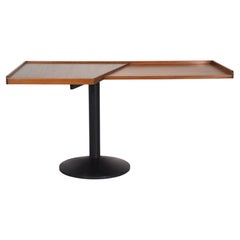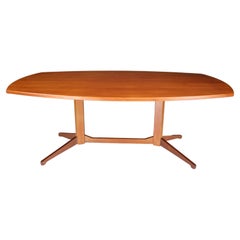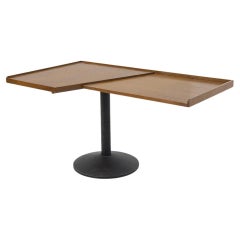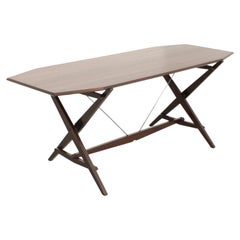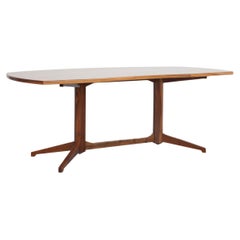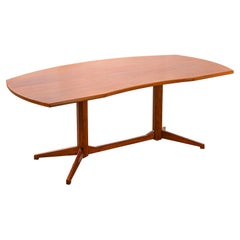Poggi Desks and Writing Tables
6
to
5
6
6
6
6
6
6
5
Height
to
Width
to
Depth
to
5
5
2
1
1
6
6
44
60
39
37
36
Creator: Poggi
Stadera Writing Desk Model 840 Franco Albini for Poggi
By Franco Albini, Poggi
Located in Rovereta, SM
Rare and important writing desk model Stadera designed by Franco Albini for the Poggi manufacture in 1959.
Model 840.
Made of noble wood for its shelf, in perfect preserved conditi...
Category
1950s Italian Mid-Century Modern Vintage Poggi Desks and Writing Tables
Materials
Iron
Franco Albini for Poggi Table or Desk, Italy, 1960s
By Franco Albini, Poggi
Located in Almelo, NL
Franco Albini for Poggi table or desk, Italy, 1960s
Walnut table TL22 model by Franco Albini for Poggi Italy 1960s. It is in excellent condition, with a minor patina on the wood parts. This unique table or desk would be an eye-catching addition to any interior, such as a living room, family room, screening room, or office. It also perfectly fits in a hospitality or corporate location like a boutique hotel lobby or luxury loft.
When you choose for used mid...
Category
Mid-20th Century Italian Mid-Century Modern Poggi Desks and Writing Tables
Materials
Wood, Walnut
Franco Albini for Poggi Model 840 Stadera Desk
By Poggi, Franco Albini
Located in Milano, IT
Rare and important desk model Stadera designed by Franco Albini for the Poggi manufacture, in 1959. Model 840. Made of noble wood for its shelf, the desk is the perfect modernist ele...
Category
1950s Italian Mid-Century Modern Vintage Poggi Desks and Writing Tables
Materials
Metal
Rare Mahogany 'TL2' Cavalletto Table / Desk by Franco Albini for Poggi, Italy
By Poggi, Franco Albini
Located in London, GB
A rare mahogany version of the Cavaletto or TL2 table designed by the great neo-rationalist designer, Franco Albini. Designed in 1950 for manufacturers Poggi...
Category
1950s Italian Mid-Century Modern Vintage Poggi Desks and Writing Tables
Materials
Steel
20th Century Franco Albini Table Model TL2 "Cavalletto" in Wood for Poggi 1950s
By Poggi, Franco Albini
Located in Turin, Turin
Iconic table designed by the great Italian maestro Franco Albini in the 50s. The model is TL2 better known as "Cavalletto" (in english "Trestle") since it reminds of lightness and wi...
Category
1950s Italian Mid-Century Modern Vintage Poggi Desks and Writing Tables
Materials
Metal
Cavalletto Dining or Working Table by Franco Albini for Poggi
By Poggi, Franco Albini
Located in Barcelona, ES
Cavalletto or TL2 dining or working table designed in 1950 by italian architect Franco Albini, old Poggi edition. Wood construction with beveled edges tabletop and crossed legs with ...
Category
1950s Italian Mid-Century Modern Vintage Poggi Desks and Writing Tables
Materials
Metal
Related Items
Desk Model TL22, by Franco Albini and Franca Helg. Poggi, 1958
By Amando Poggi, Franco Albini and Franca Helg
Located in Wolfurt, AT
Desk model TL22, designed by Franco Albini and Franca Helg and manufactured by Poggi in 1958.
Table completely restored. Wood: walnut.
Letteratura: Gramigna G., Repertorio del desig...
Category
1950s Italian Mid-Century Modern Vintage Poggi Desks and Writing Tables
Materials
Walnut
Franco Albini Rosewood Mid-Century Modern “LB7” Modular Bookcase for Poggi, 1957
By Poggi, Franco Albini
Located in Vicenza, IT
LB7 bookcase, designed by Franco Albini and manufactured by Poggi in 1957.
Modular bookstore composed by upholds, containers with flying and doors, shelve. The industrial standard for every product component allows permanent and different solutions, from the bearing structures to the elements. The structure does not need anchorages to the wall and can be placed in the middle of the space.
This set is composed of 3 modules, ten shelves, and three containers.
It is made of Rosewood, iron, and brass.
Excellent vintage condition.
Franco Albini was born in Robbiate in 1905, and after his childhood and part of his youth, he moved to Milan.
He graduated at Politecnico of Milan, Faculty of Architecture, in 1929, and He collaborated for three years in Giò Ponti and Emilio Lancia’s office. He probably had his international contacts here, at The International Exposition of 1929 in Barcelona and Paris, where he visited le Corbusier’s office, as Franca Helg used to tell.
Throughout these first three years, his works were undoubtedly related to XIXth Century. His meeting with Edoardo Persico marks an evident turnover towards rationalism and writers for “Casabella” magazine. Persico’s thoughtful and ironical comments on some of Albini’s drawings for office furniture caused him deep upsetting. “I spent days of real anxiety – tells Albini – I had to answer all questions. I had a long fever”.
The new phase that the meeting provoked begins with opening his own first office at Via Panizza with Renato Camus and Giancarlo Palanti. The group of Architects starts taking care of social housing, participating in the competition for the Baracca neighborhood in 1932, and then realizing the Ifacp neighborhood: Fabio Filzi (1936/38), Gabriele D’Annunzio, and Ettore Ponti (1939).
During those years, He also worked for his first private villa (Pestarini).
It is mainly in the context of exhibitions that the Italian architect experiments the compromise between rigor and poetic fantasy that Pagano was talking about; He conceived all the elements that would become recurrent in all types of his work – Architecture, Interiors, Design. The 1933 opening of the new Triennale of Milano, in Palazzo dell’Arte, becomes an occasion to express the highly innovative character of rationalist thinking. In this place, to experiment with new materials and solutions, but most of all a “method”.
Young rationalist architects cultivated the art of exhibiting as a communication lab, an open field to space solutions.
Albini, with Giancarlo Palanti, sets the steel structure house (with R. Camus, G. Mazzoleni, G. Minoletti and coordination by G. Pagano) designing also its furniture. For the next Triennale in 1936, marked by Persico’s early death, Franco Albini, together with a group of young architects around Pagano, takes care of the exhibition of Dwelling, where he presented 3 types of lodgings.
In the same year, Albini and Romano design the exhibition for Ancient Italian jewelry: vertical uprights, simple linear poles design space. This element is recurring in other works, like the Scipione exhibition (1941), Vanzetti stand (1942), and Olivetti shop in Paris (1956). The architectural space is readable through a grid, introducing a third dimension, the vertical one, with a sense of lightness and transparency.
Upright is also used in design objects, such as the Veliero bookcase...
Category
1950s Italian Mid-Century Modern Vintage Poggi Desks and Writing Tables
Materials
Brass, Iron
H 109.45 in W 104.34 in D 13.78 in
Franco Albini for Knoll Desk Model '1928' in Glass and Metal
By Knoll, Franco Albini
Located in Waalwijk, NL
Franco Albini for Knoll, desk model '1928', glass, wood, chromed steel, Italy, design 1949
Franco Albini’s '1928' desk combines glass, steel...
Category
1940s Italian Mid-Century Modern Vintage Poggi Desks and Writing Tables
Materials
Steel
Rustic Solid Teak Desk / Table, France 1960s
Located in Echt, NL
Rustic desk / table in very good original condition.
This desk / Table is made from rustic solid teak wood which has a stunning woodgrain and patina.
The sides are connected to the top with beautiful joints.
Its reduced shape creates a raw simplicity. It is minimalist and pure, avoiding any non-sense and almost has Japanese design character.
We offer a variety of insured shipping services, ask us for the possibilities and competitive pricing.
If you have any questions about our shipping options or this item please feel free to contact us.
The style reminds of the French designers Pierre Chapo...
Category
20th Century French Mid-Century Modern Poggi Desks and Writing Tables
Materials
Wood, Teak
Desk "1928" by Franco Albini for Knoll International, Italy, 1950s
By Franco Albini
Located in Greding, DE
Desk "1928" designed by Franco Albini for Knoll International, Italy, 1950s. This glass and metal desk features a veneered white drawer element an...
Category
1950s Italian Mid-Century Modern Vintage Poggi Desks and Writing Tables
Materials
Metal
Franco Albini Italian Midcentury Desk for Knoll 70's
By Franco Albini
Located in bari, IT
Stickers.Stunning Franco Albini '1928' desk for Knoll international, this example 1958. A pebbled glass top and stunning patina really take this piece...
Category
1970s Italian Mid-Century Modern Vintage Poggi Desks and Writing Tables
Materials
Steel
Franco Albini Cavalletto Table for Cassina, Italy, new
By Cassina, Franco Albini
Located in Berlin, DE
Available in Canaletto Walnut, natural ash and black stained ash. Prices vary dependent on the chosen material/finish.
Table designed by Franco Albini in 1950. Relaunched in 2008...
Category
21st Century and Contemporary Italian Mid-Century Modern Poggi Desks and Writing Tables
Materials
Metal
Marvellous "Rocco" Wood Desk - Table by Roberto Pamio for Peguri, Italy, 1960s
Located in Milan, IT
"Rocco" Desk/Table in massive wood with a beautiful construction, on both legs and top. Designed by Roberto Pamio for Peguri in 1969.
Italian production of the late Sixties, it reme...
Category
1960s Italian Vintage Poggi Desks and Writing Tables
Materials
Wood
H 28.75 in W 78.75 in D 27.56 in
Franco Albini Italian Mid-Century Walnut Dining Table
By Franco Albini
Located in New York, NY
Italian mid-century walnut dining table resting on four tapered legs (att: FRANCO ALBINI)
Category
Mid-20th Century Mid-Century Modern Poggi Desks and Writing Tables
Materials
Walnut
Franco Albini Mahogany mid-centry Italian Table Model TL-22 produced by Poggi
By Franco Albini
Located in Barcelona, ES
Franco Albini & Franca Helg.
Dining table model no. TL22.
Manufactured by Poggi,
Italy, 1958.
Mahogany.
Measurements:
180.3 cm x 104.1 cm x 73 H cm.
70.98 in x 40.98 in x 28.74 in.
Literature:
Giuliana Gramigna, Repertorio 1950/1980, Milan, 1985, p. 123.
Franco Albini, was born in 1905 and died in 1977. He spent his childhood and part of his youth in Robbiate in Brianza, where he was born. Albini, as an adolescent moved with his family to Milan. Here he enrolled in the Faculty of Architecture of the Polytechnic and graduated in 1929. He started his professional activity in the studio of Gio Ponti and Emilio Lancia, with whom he collaborated for three years. At the 1929 International Exhibition in Barcelona (where Gio Ponti curated the Italian pavilion and Mies van der Rohe realized that of Germany) and in Paris where, as Franca Helg recounted, he had the opportunity to visit the studio by Le Corbusier.
In those three years, the works he carried out are admittedly of the twentieth century imprint. It is the meeting with Edoardo Persico that marked a clear turning point towards rationalism and the approach to the group of editors of "Casabella". The partly ironic and partly very harsh comments of the Neapolitan critic to a series of drawings, made by Albini for the design of some office furniture, caused him a great disturbance. “I spent days of real anguish - Albini recalls - I had to answer all the questions. I also had a fever, a large and long fever. "
The meted provoked Albini to openen a professional studio in via Panizza with Renato Camus and Giancarlo Palanti. The group of architects began to deal with public housing by participating in the competition for the Baracca district in San Siro in 1932 and then building the IFACP neighborhoods: Fabio Filzi (1936/38), Gabriele D'Annunzio and Ettore Ponti (1939).
During this period, Albini also worked on his first villa (Pestarini), which Giuseppe Pagano, architect and critic of the time, presented as follows: “This coherence, which the superficial rhetoric of fashionable jugglers calls intransigence, and which is instead the basis of understood between the fantasy of art and the reality of the craft, in Franco Albini, it is so rooted that it transforms theory into a moral attitude ".
But it is above all in the context of the exhibitions that the Milanese master experienced his compromise between that "rigor and poetic fantasy" of which Pagano speaks, coining the elements that became a recurring theme in his . The opening in 1933 of the new Triennale headquarters in Milan, in the Palazzo dell'Arte, was an important opportunity to express the strong innovative character of rationalist thinking, a gym in which to freely experiment with new materials and new solutions, but above all a "method". "Cultivated as a communication laboratory, the art of setting up was for the rationalists of the first generation what the perspective had been for the architects of humanism: the field open to a hypothesis of space that needed profound reflections before landing the concreteness of the construction site ".
Together with Giancarlo Palanti, Albini on the occasion of the V Triennale di Milano set up the steel structure house (with R. Camus, G. Mazzoleni, G. Minoletti and with the coordination of G. Pagano), for which he also designed the 'furniture. At the following Triennale of 1936, Persico dided, together with a group of young designers gathered by Pagano in the previous edition of 1933, Franco Albini took care of the preparations of the home exhibition. The setting up of Stanza per un uomo, at that same Triennale, allows us to understand the acute and ironic approach of Albini, as a man and as a designer: "Celebrating the beauty of mechanics was the imperative to which, for example, the surprising displays by Franco Albini who managed, in the subtle way of a refined and rarefied style, to sublimate their practical content in the metaphysics of daring still lifes: flying objects which marked in the void refined frames and metal intricacies the nodes of a fantastic cartography where industry finally became art free from purpose ".
That same year Albini and Romano designed the exhibition of the Ancient Italian Goldsmithery: vertical uprights, simple linear rods, designed the space. A theme, of the "flagpole", seemed to be the center of the evolution of production and the creative process. The concept is reworked over time, with the technique of decomposition and recomposition typical of Albinian design: in the preparation of the Scipione Exhibition and contemporary drawings (1941) the tapered flagpoles, on which the paintings and display cases were hung, are supported by a grid of steel cables; in the Vanzetti stand (1942) they take the V-shape; in the Olivetti shop in Paris (1956) the polished mahogany uprights support the shelves for the display of typewriters and calculators.
The flagpole is found, however, also in other areas. In the apartments he designed, it is used as a pivot on which the paintings can be suspended and rotated to allow different points of view, but at the same time as an element capable of dividing the spaces. The Veliero bookcase...
Category
Mid-20th Century Italian Mid-Century Modern Poggi Desks and Writing Tables
Materials
Mahogany
H 28.75 in W 40.95 in D 70.87 in
Dining Room Table / Franco Albini / 1951
By Franco Albini
Located in Berlin, DE
The unusual feature of this table is the solid wooden top.
This graceful table by Italian architect and designer Franco Albini was designed in 1951. The model, known as 'TL2', is ma...
Category
Mid-20th Century Italian Mid-Century Modern Poggi Desks and Writing Tables
Materials
Iron
Franco Albini TL2 Cavalletto table Poggi Italy 1950
By Franco Albini
Located in Roosendaal, Noord Brabant
Iconic and early example of the TL2 'Cavalletto' table designed by Franco Albini and manufactured by Poggi in Italy around 1950. The table has an amazing dynamic and archtectural sha...
Category
1950s Italian Mid-Century Modern Vintage Poggi Desks and Writing Tables
Materials
Brass
Previously Available Items
Franco Albini Cavalletto Table for Poggi, Italy
By Poggi, Franco Albini
Located in Rivoli, IT
This table, with its minimal lines and an extremely light look, underscores the extensive thought, by Franco Albini, and the advanced wood-working skills, by Poggi, that went into it...
Category
1950s Italian Mid-Century Modern Vintage Poggi Desks and Writing Tables
Materials
Wood
20th Century Franco Albini for Poggi Large Desk mod. T22 in Wood, 50s
By Poggi, Franco Albini
Located in Turin, Turin
Franco Albini (1905-1977) lived in Milan where he stuied Architecture at the Politecnico. He started his career at Gio Ponti's studio, with whom he collaborated before getting in tou...
Category
1950s Italian Mid-Century Modern Vintage Poggi Desks and Writing Tables
Materials
Wood
H 28.75 in W 77.96 in D 40.16 in
Franco Albini Midcentury Italian Wood ‘TL2’ Model Treste Table for Poggi, 1950s
By Poggi, Franco Albini
Located in Reggio Emilia, IT
Italian midcentury modern design trestle table model TL2 designed by Franco Albini and manufactured by Poggi,
table designed according to structuralist criteria with solid wood trest...
Category
1950s Italian Mid-Century Modern Vintage Poggi Desks and Writing Tables
Materials
Metal
H 27.96 in W 70.87 in D 27.56 in
Franco Albini Poggi Wood Steel Desk Mod. Stadera Italy 1958 Excellent Patina
By Poggi, Franco Albini
Located in Catania, IT
This Stadera desk/table designed by Franco Albini was manufactured by Poggi in Italy in 1958.
This desk is in teak wood and has two side-by-side trapezoi...
Category
1950s Italian Mid-Century Modern Vintage Poggi Desks and Writing Tables
Materials
Steel
H 28.75 in W 56.3 in D 32.68 in
Trabucco and Vecchi ‘SC73’ Desk for Poggi, Italy, 1983
By Poggi, Trabucco, Vecchi, Volpi
Located in London, GB
Compasso d’oro winning Architect-designers Marcello Vecchi and Francesco Trabucco, collaborated on this desk in 1983 for Poggi, Pavia, 1983. The Italian maker Poggi (1924-) was famous for championing the designs of other notable architects, the neo-rationalist Franco Albini (1905-1977). Trabucco is known for designing the Blitz lamp...
Category
1980s Italian Post-Modern Vintage Poggi Desks and Writing Tables
Materials
Teak
F. Albini & F. Helg for Poggi, 1958 Italy Modern Wood Desk Table "T22" Model100
By Franco Albini, Poggi
Located in Palermo, IT
Beautiful and original desk "T22" model designed by Franco Albini & Franca Helg for Poggi in 1958.
Totally recently restored with artisanal technique.
Wear consistent with age and...
Category
1950s Italian Mid-Century Modern Vintage Poggi Desks and Writing Tables
Materials
Metal
H 29.53 in W 78.75 in D 39.38 in
Franco Albini 1950 Century Modern Wood Desk Table
By Franco Albini, Poggi
Located in Palermo, IT
Beautiful and original desk designed by Franco Albini for Poggi in 1958.
Totally recently restored with artisanal technique.
Wear consistent with age and use.
Category
1950s Italian Mid-Century Modern Vintage Poggi Desks and Writing Tables
Materials
Metal
Franco Albini "TL2" Table for Poggi
By Poggi, Franco Albini
Located in Milan, IT
Franco Albini "TL2" table for Poggi.
Category
1950s Italian Mid-Century Modern Vintage Poggi Desks and Writing Tables
Materials
Metal
Poggi desks and writing tables for sale on 1stDibs.
Poggi desks and writing tables are available for sale on 1stDibs. These distinctive items are frequently made of wood and are designed with extraordinary care. There are many options to choose from in our collection of Poggi desks and writing tables, although brown editions of this piece are particularly popular. Many of the original desks and writing tables by Poggi were created in the mid-century modern style in italy during the mid-20th century. If you’re looking for additional options, many customers also consider desks and writing tables by Cantieri Carugati, Paolo Buffa, and MIM Roma. Prices for Poggi desks and writing tables can differ depending upon size, time period and other attributes — on 1stDibs, these items begin at $6,250 and can go as high as $16,687, while a piece like these, on average, fetch $10,433.
